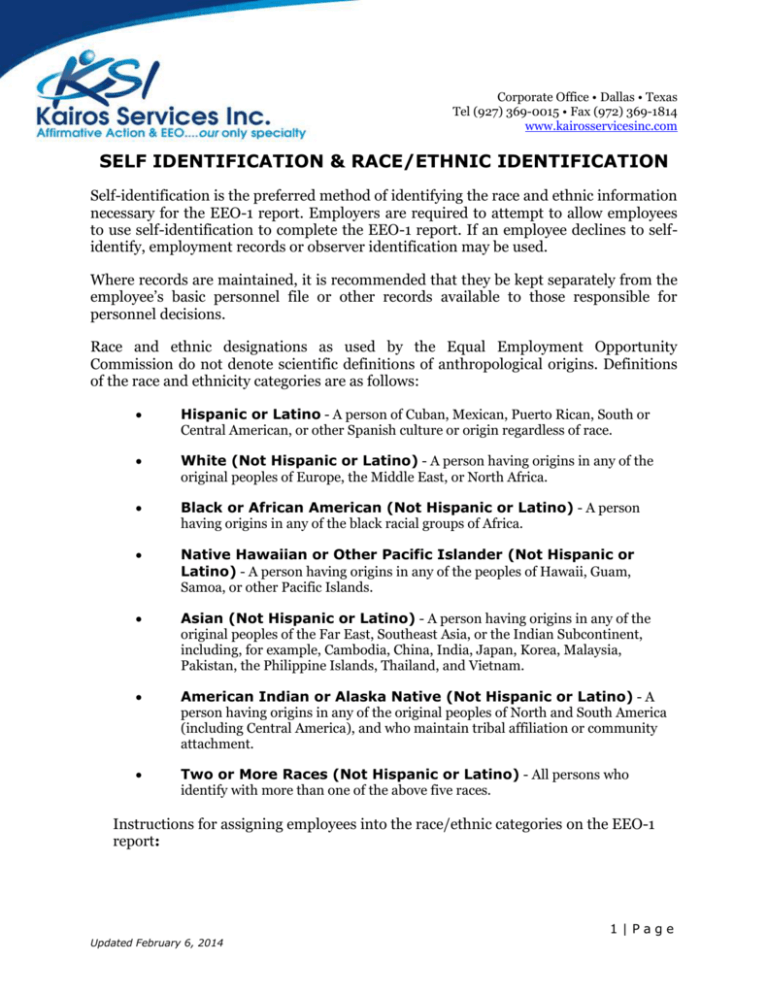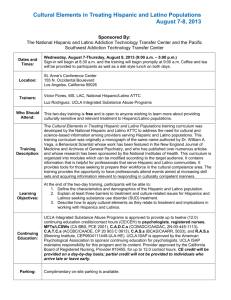Race-Ethnic Identification
advertisement

Corporate Office • Dallas • Texas Tel (927) 369-0015 • Fax (972) 369-1814 www.kairosservicesinc.com SELF IDENTIFICATION & RACE/ETHNIC IDENTIFICATION Self-identification is the preferred method of identifying the race and ethnic information necessary for the EEO-1 report. Employers are required to attempt to allow employees to use self-identification to complete the EEO-1 report. If an employee declines to selfidentify, employment records or observer identification may be used. Where records are maintained, it is recommended that they be kept separately from the employee’s basic personnel file or other records available to those responsible for personnel decisions. Race and ethnic designations as used by the Equal Employment Opportunity Commission do not denote scientific definitions of anthropological origins. Definitions of the race and ethnicity categories are as follows: Hispanic or Latino - A person of Cuban, Mexican, Puerto Rican, South or Central American, or other Spanish culture or origin regardless of race. White (Not Hispanic or Latino) - A person having origins in any of the original peoples of Europe, the Middle East, or North Africa. Black or African American (Not Hispanic or Latino) - A person having origins in any of the black racial groups of Africa. Native Hawaiian or Other Pacific Islander (Not Hispanic or Latino) - A person having origins in any of the peoples of Hawaii, Guam, Samoa, or other Pacific Islands. Asian (Not Hispanic or Latino) - A person having origins in any of the original peoples of the Far East, Southeast Asia, or the Indian Subcontinent, including, for example, Cambodia, China, India, Japan, Korea, Malaysia, Pakistan, the Philippine Islands, Thailand, and Vietnam. American Indian or Alaska Native (Not Hispanic or Latino) - A person having origins in any of the original peoples of North and South America (including Central America), and who maintain tribal affiliation or community attachment. Two or More Races (Not Hispanic or Latino) - All persons who identify with more than one of the above five races. Instructions for assigning employees into the race/ethnic categories on the EEO-1 report: 1|Page Updated February 6, 2014 Hispanic or Latino - Include all employees who answer YES to the question, Are you Hispanic or Latino. Report all Hispanic males in Column A and Hispanic females in Column B. White (Not Hispanic or Latino) - Include all employees who identify as White males in Column C and as White females in Column I. Black or African American (Not Hispanic or Latino) - Include all employees who identify as Black males in Column D and as Black females in Column J. Native Hawaiian or Other Pacific Islander (Not Hispanic or Latino) - Include all employees who identify as Native Hawaiian or Other Pacific Islander males in Column E and as Native Hawaiian or Other Pacific Islander females in Column K. Asian (Not Hispanic or Latino) - Include all employees who identify as Asian males in Column F and as Asian females in Column L. American Indian or Alaska Native (Not Hispanic or Latino) Include all employees who identify as American Indian or Alaska Native males in Column G and as American Indian or Alaska Native females in Column M. Two or More Races (Not Hispanic or Latino) - Report all male employees who identify with more than one of the above five races in Column H and all female employees who identify with more than one of the above five races in Column N. As to the method of collecting data, the basic principles for ethnic and racial selfidentification for purposes of the EEO-1 report are: 1) Offer employees the opportunity to self- identify 2) Provide a statement about the voluntary nature of this inquiry for employees. For example, language such as the following may be used (employers may adapt this language): "The employer is subject to certain governmental recordkeeping and reporting requirements for the administration of civil rights laws and regulations. In order to comply with these laws, the employer invites employees to voluntarily self-identify their race or ethnicity. Submission of this information is voluntary and refusal to provide it will not subject you to any adverse treatment. The information obtained will be kept confidential and may only be used in accordance with the provisions of applicable laws, executive orders, and regulations, including those that require the information to be summarized and reported to the federal government for civil rights enforcement. When reported, data will not identify any specific individual." Source: Instructions for Employer Information Report EEO-1, Standard Form 100, Rev. January 2006: http://www.eeoc.gov/eeo1/instruction_rev_2006.html 2|Page Updated February 6, 2014







